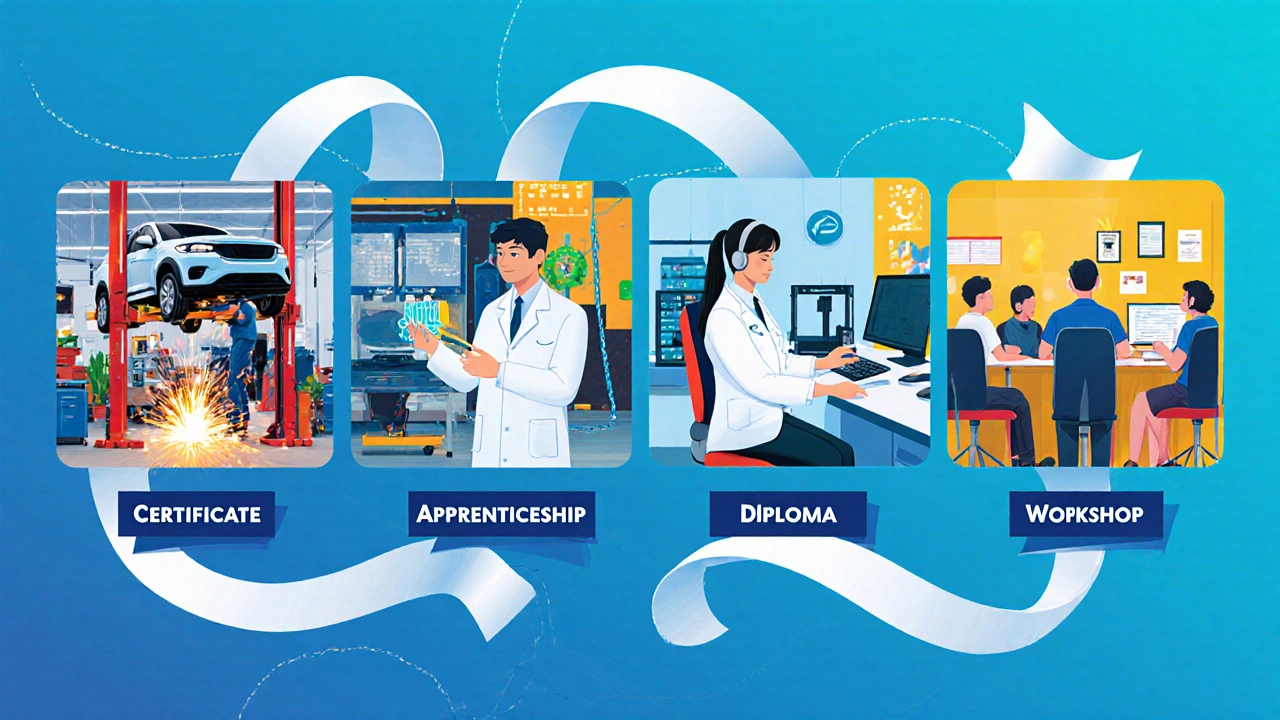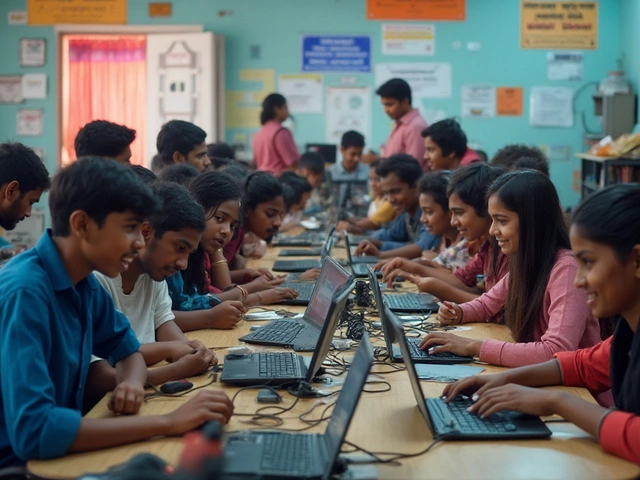Vocational Course Finder
Find Your Perfect Vocational Course
Select your preferences to get personalized recommendations for vocational courses that match your goals.
Your Career Goals
Your Interests
Your Learning Preference
Your Time Commitment
Your Recommended Courses
Quick Takeaways
- Vocational courses are short‑to‑medium‑length programmes that teach specific job skills.
- They can be delivered by trade schools, colleges, industry bodies or online platforms.
- India’s NSQF levels 1‑4 cover most entry‑level vocational programmes.
- Apprenticeships blend classroom learning with paid on‑the‑job experience.
- Choosing the right course depends on your career goals, industry demand and learning style.
What Exactly Is a Vocational Course?
When you hear vocational courses, you probably think of short, practical training that leads straight to a job. In plain terms, a vocational course is a structured learning programme that focuses on the skills, knowledge and attitudes needed for a specific occupation or trade. Unlike academic degrees that emphasize theory, vocational courses prioritize hands‑on practice, industry standards and immediate employability.
Vocational course is a skill‑oriented educational pathway designed to prepare learners for a particular job or trade, often shorter in duration than a traditional degree. These programmes can range from a few weeks (e.g., a basic computer‑operation workshop) to two years (e.g., a diploma in electrical engineering).
Key Players and Frameworks Behind Vocational Education
India’s vocational landscape is anchored by the National Skills Qualifications Framework (NSQF). NSQF provides a unified system of levels (1‑10) that describe the skill depth and knowledge required for each occupation. Most entry‑level vocational courses sit at NSQF levels 1‑4, aligning them with industry‑recognized competency standards.
The Ministry of Skill Development and Entrepreneurship (MSDE) oversees policy, funding and quality assurance for these programmes. Through initiatives like the Pradhan Mantri Kaushal Vikas Yojana (PMKVY), the government subsidises training for millions of youth, making vocational courses more accessible across India.

Common Types of Vocational Courses
Not all vocational programmes look the same. Understanding the main formats helps you pick the one that matches your learning style and career plan.
| Format | Typical Duration | Learning Mode | Certification |
|---|---|---|---|
| Certificate Program | 3‑12 months | Classroom or online, instructor‑led | Industry‑recognized certificate (often NSQF level 1‑3) |
| Apprenticeship | 6‑24 months | On‑the‑job + periodic classroom sessions | Apprenticeship completion certificate + skill‑grade |
| Diploma | 1‑2 years | Full‑time institute or polytechnic | Diploma (NSQF level 3‑4), often accepted for higher education |
| Short‑Term Skill Workshop | 1‑6 weeks | Hands‑on labs, project‑based | Participation certificate; may count as micro‑credential |
Each format serves a different need. If you want a quick boost to your résumé, a short‑term workshop or certificate may suffice. For deeper expertise and eligibility for higher studies, a diploma or apprenticeship is a better fit.
Popular Vocational Fields in India (2025)
Some sectors are seeing a surge in demand for skilled workers. Here are five high‑growth areas where vocational courses can fast‑track your career:
- Information Technology (IT) support - courses in hardware troubleshooting, networking basics (CCNA‑style), and help‑desk communication.
- Healthcare support - certification for medical lab assistants, phlebotomy, and basic patient care.
- Automotive services - training in electric‑vehicle maintenance, diesel engine overhaul, and diagnostic tools.
- Hospitality and tourism - front‑office operations, food safety (FSSAI) training, and event management.
- Renewable energy technology - solar panel installation, solar‑pump maintenance, and basic energy auditing.
These fields are backed by government incentives and private‑sector hiring spikes, meaning a graduate from a relevant vocational course can often land a job within three months of completion.
How to Choose the Right Vocational Course for You
Choosing a course isn’t just about the subject; it’s about aligning the programme with your personal and professional goals. Follow this simple checklist:
- Career goal clarity: Identify the exact role you want (e.g., “junior network technician” vs. “software tester”).
- Industry relevance: Look for courses mapped to NSQF levels and recognised by industry bodies.
- Delivery mode: Decide if you need a classroom experience, an online module, or a blended apprenticeship.
- Duration vs. income need: Shorter courses suit those who need quick earnings; longer programmes suit career changers.
- Placement support: Institutes offering campus recruitment, industry tie‑ups, or a strong alumni network add extra value.
For example, a recent graduate in Bangalore who wanted a fast entry into the IT support field enrolled in a six‑month certificate program offered by a local polytechnic. The course was NSQF‑level‑2, had a 90% placement record with nearby IT parks, and included a two‑week on‑site apprenticeship at a cloud‑services firm. Within two months of graduation, the student secured a junior technician role with a salary of INR3.5Lakhs per annum.
Financial Aid and Scholarships for Vocational Learners
Cost can be a barrier, but several schemes help reduce the financial load:
- PMKVY Skill Development Initiative - provides up to 100% fee waivers for eligible youth.
- State Skill Development Missions - many states, including Karnataka, offer subsidised training slots in sectors like automotive and hospitality.
- Bank loans with low interest rates specifically tailored for vocational education, often tied to the student's future earnings.
- Private‑sector scholarships from industry giants (e.g., Tata Motors apprenticeship scholarship) that combine tuition with a paid stipend.
Always check the eligibility criteria-most schemes require Indian citizenship, age limits (18‑35), and a basic educational qualification (10th or 12th grade).

Real‑World Impact: Success Stories
Seeing the numbers is great, but personal stories illustrate the transformational power of vocational learning.
- Ravi, 22, Bengaluru: After a year of unemployment, Ravi completed a 9‑month diploma in automotive electric‑vehicle technology. He landed a job at a leading EV startup, earning INR4.2Lakhs annually.
- Meera, 19, Mysore: She pursued a 6‑month certificate in medical lab assistance under PMKVY. Within three months, she was hired by a private hospital, with a clear pathway to a full‑time lab technician role.
- Arun, 28, Hyderabad: After working as a freelance graphic designer, Arun enrolled in an online digital marketing apprenticeship. The blend of theory and on‑the‑job projects helped him secure a senior associate position at a digital agency, increasing his income by 45%.
These examples highlight three recurring themes: short‑duration training, industry‑aligned curricula, and strong placement support.
Future Trends Shaping Vocational Education
Vocal predictions from the Ministry of Skill Development suggest three major trends for the next five years:
- Micro‑credentialing: Badges and digital certificates that validate specific skill blocks (e.g., “Python for Data Cleaning”).
- AI‑driven personalised pathways: Adaptive learning platforms that recommend next courses based on performance data.
- Industry‑college co‑creation: Companies co‑designing curricula, ensuring that every hour of training directly maps to a job requirement.
Staying aware of these trends helps learners choose programmes that won’t become outdated within a year or two.
Frequently Asked Questions
What is the difference between a vocational course and a regular college degree?
A vocational course focuses on specific job skills, usually lasting from a few weeks to two years, and ends with a skill‑based certification. A regular degree covers broader academic subjects over three to four years, often culminating in a bachelor’s degree that may not directly translate to a particular role.
Are vocational courses recognized across India?
Yes. When a course is aligned with the NSQF and approved by the Ministry of Skill Development, its certification is nationally valid. Many state skill missions also endorse these programmes.
How much do vocational courses cost?
Costs vary widely. A short‑term workshop might be under INR5,000, while a two‑year diploma can range from INR20,000 to INR60,000. Government schemes like PMKVY can cover up to 100% of the fee for eligible candidates.
Can I switch from a vocational course to a traditional degree?
Many diploma programmes are designed for lateral entry into bachelor’s degrees. Credits earned under NSQF levels 3‑4 are often accepted by universities for second‑year admission.
Is online vocational training as effective as classroom training?
Effectiveness depends on the field. For software‑related skills, online labs and simulation tools can match classroom outcomes. For trades that require physical handling-like welding or automotive repair-hands‑on sessions or hybrid models are essential.
Next Steps: Turning Knowledge into a Career
If you’re ready to start, follow these three actions:
- Identify the exact role you want and check the corresponding NSQF level on the Ministry’s portal.
- Search for institutes or online platforms offering a certified programme at that level. Look for placement records and industry tie‑ups.
- Apply for any applicable financial aid-PMKVY, state missions, or private scholarships-before the enrollment deadline.
Remember, the goal isn’t just to earn a certificate; it’s to acquire the competence that employers value today. Choose a course that gives you both skill depth and a clear path to a job, and you’ll see the return on investment faster than you expect.



